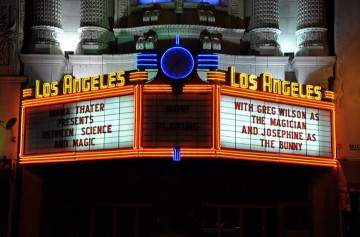
Diana Thater, "Los Angeles Theatre Marquee," 35mm production still from "Between Science and Magic," 2010. Courtesy the artist.
The Oscars, aka prom night for Hollywood, are just around the corner! Who does The Academy love more: the noble savage, the noble soldier, or the noble soldier–turned-savage? Are you on the edge of your seat or what?
If you answered “or what” to that question, you might prefer to spend this Sunday at the Santa Monica Museum of Art, whose current exhibitions offer an excellent antidote to “movie magic.” Disassembling that particular phrase is the crux of preeminent video/film/installation artist Diana Thater‘s newest work, Between Science and Magic. Thater’s installation (also on view across the country at David Zwirner Gallery until March 13) features a film of a magician repeatedly performing the iconic rabbit-in-a-hat trick, while Jeffrey Wells‘s concurrent exhibition, Seeing While Seeing, represents a clever manifestation of Wells’s own distinctive approach to deconstructing parallel themes of illusion, trickery, and suspension of disbelief.
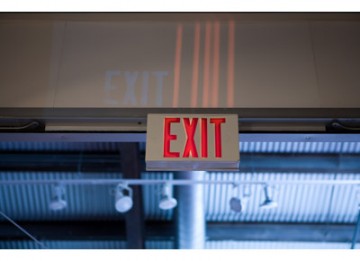
Jeffrey Wells, "Seeing While Seeing," installation view, 2010. Courtesy Santa Monica Museum of Art.
The low-tech trompe l’oeil animations in Wells’s installation are just as psychedelic and phantasmagoric as the high-end CGI phosphorescent forests in Avatar, and are far more lively and dimensional. As you enter the museum’s project room, the walls begin to dissolve before your eyes. With a series of subtle projections, Wells deftly liquifies two corners of the room into wiggly lines, while strange after-image-like rectangles appear and disappear around the two pictures that hang on adjacent walls. Even as you attempt to anchor yourself by reading the exhibition’s wall text, the letters begin to dance off the page, glowing and pulsating. The exit sign suspended at the top of the doorway echoes itself onto the nearby ceiling and opposite wall, as though reflecting itself onto a watery surface. The effect of the work is simultaneously disquieting and invigorating. Suddenly, the world around you feels malleable, porous, and oddly comical. The projectors are revealed, but it’s not entirely possible to determine exactly how Wells produces these strange effects – and you kind of don’t want to know. Wells, like a magician, has performed a trick that leaves his audience buoyant with pleasant bewilderment and inquisitiveness.
Meanwhile, on the other side of Wells’s mutating wall, Diana Thater addresses both the intersection and divergence of art and magic in her installation commissioned by the SMMoA. I must say that I find it a bit of a stretch to describe this particular work as an installation, although Thater herself would probably argue that projecting her film on the wall of the Santa Monica Museum constitutes it as such. I would disagree entirely with this classification were it not for the two speakers that amplify the mechanical whirring of her two film projectors. This effect ultimately allows the work to fill the vast space of SMMoA’s main gallery, rather than simply existing on a single plane. In addition, the piece is comprised of two separate films, though the projectors align to produce a symmetrically balanced split-screen effect.
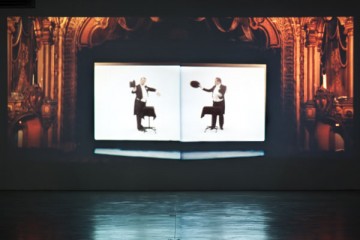
Diana Thater, "Between Science and Magic," 2010. Two 16mm films, 2 modified Eiki RT-0 projectors with custom loopers, 2 amplifiers, 2 equalizers, 4 speakers. Dimensions variable. Installation view, Santa Monica Museum of Art, Santa Moica, CA, 2010. Courtesy the artist.
The film begins with a double-vision moment, in which famed magician Greg Wilson appears simultaneously in both projections, executing the classic magician’s feat of producing a white rabbit from an ostensibly empty hat. In a rather tired gesture of meta-ness, Thater initially shot the sequence in her studio, then screened it at the historic Los Angeles Theatre–the self-proclaimed “last and most extravagant of the ornate movie palaces,” constructed between 1911 and 1931. She then filmed that screening, so what you’re actually watching is…(drumroll please)…a film of a film. Did that just blow your mind or what?
The left-hand camera orbits Wilson counterclockwise, filming the scene from a new angle as he repeats the trick in 14 different takes, while the right-hand camera remains stationary. His actions and timing are so exacting that it is impossible to determine at first if the right-hand projection is comprised of the same take on a loop, or if Wilson is executing the trick multiple times. Meanwhile, this temporary disorientation is multiplied by the initial ambiguity of the left-hand screen. During the first half of the film, it seems as though the magician himself is rotating clockwise. Thus, the mechanisms behind Thater’s process remain just as opaque as the magician’s, until finally a camera appears in the background of each film (manned by Thater and her director of photography, respectively). “Crossing the line” and exposing the crew are signatures of Thater’s films, but I believe that the maneuver takes on greater significance in this particular piece. While LA Times critic David Pagel bemoans Thater’s “dreary” attempt to distance her artwork from the lowly world of entertainment, I am inclined to disagree with his qualms — not only because his review is part of a longstanding personal feud with Thater, but because I find the work ultimately rather generous. Although revealing the crew in this moment does serve to distance the piece from the slick universe of “movie magic,” it simultaneously decreases the distance between the viewer and the work. Suddenly, you find yourself in on the joke, becoming privy to the “science” behind Thater’s “magic.” And in that moment, the work feels satisfying and generous, despite its aura of austerity.
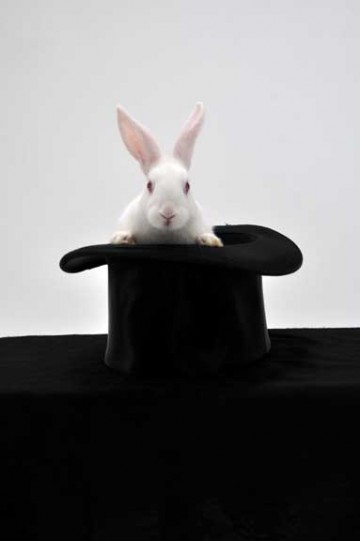
Diana Thater, "Josephine," 35mm production still from "Between Science and Magic," 2010. Commissioned by the Santa Monica Museum of Art. Courtesy Hauser & Wirth, London and David Zwirner, New York.
Diana Thater: Between Science and Magic and Jeffrey Wells: Seeing While Seeing are on view through April 17, 2010, along with Nira Pereg: Sabbath 2008, a video projection that also explores ideas of illusion, transformation, and staging. For more ruminations on the dubious confluence of art, magic, and entertainment, check out Karthik Pandian’s Grand Canyon Journals.
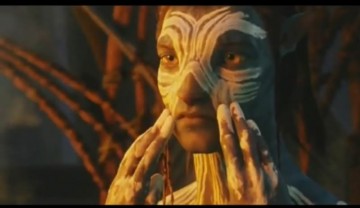
Noble soldier transforms into noble savage in "Avatar." Via Hollybeam at photobucket.com




Pingback: Snowboarding Philadelphia Museum of Art | Pink Snow Boots